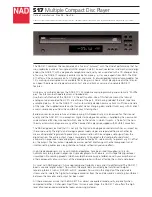
10602248_V_1_0.DOC
18/43
4.2 Frontpanel
SEAMLESS LOOP
CDP-180
SINGLE CD PLAYER
1 BIT 8 TIMES OVERSAMPLING D/A CONVERTER COMPACT DISC PLAYER
REMOTE
SENSOR
1
2
3
4
5
6
7
8
9
11
12
13
14
15
16
17
18
19
10
20
1. POWER SWITCH
Press this button to start operation.
2. DISC-TRAY
To enter the disc. Please refer to the explanations under 6.2 CD-tray.
3. INFRARED SENSOR
For receiving signals of the optional remote control.
4. OPEN/CLOSE BUTTON
Via the Open/Close-button, you can open and close the CD-tray.
5. SHUTTLE/JOG-WHEEL
Playback-mode:
Via the Shuttle-wheel (outer ring), you can quickly scan forwards and backwards. Turn the Shuttle-wheel to
the right in order to scan forwards and turn it to the right in order to scan backwards. The further you turn the
Shuttle-wheel the higher the scanning-speed.
Pause-mode:
In the pause-mode, the current frame is repeated as soon as you turn the Shuttle-wheel.
Playback-mode:
Via the Jog-wheel (inner ring), you can temporarily adjust the playback-speed by ± 12 %.
Pause-mode:
In the pause-mode, the current frame is repeated as soon as you turn the Jog-wheel.
Via the Jog-wheel, you can slowly search within a title forwards and backwards. In this way, you can easily
find a Cue-point for example.Turn the Jog-wheel to the right in order to search forwards and turn it to the
right in order to search backwards. The faster you turn the Jog -wheel the higher the searching-speed.
6. DISPLAY
LCD-display for displaying the different modes and functions. Please refer to the explanations under 6.3
LCD-display.
7. TRACK-BUTTONS
Via the Track-buttons, you can select the desired track. Please refer to the explanations under 6.5 Selecting
a track via the Track-buttons.
8. CUE-BUTTON
Pause-mode:
In the pause-mode, you can cue by pressing and holding the Cue-button. As soon as you let the Cue-button
loose, the player returns to the track-start.
Playback-mode:
If you press the Cue-button during playback, the player returns to the position where the playback started
and goes into Pause-mode.
Please refer to the explanations under 6.8 Cueing.
















































